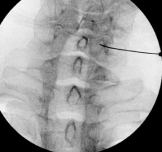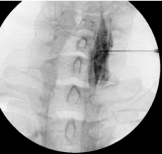
Case Report
Austin J Anesthesia and Analgesia. 2021; 9(1): 1094.
Use of Stellate Ganglion Local Anesthetic Blockade for Treatment of Complex Regional Pain Syndrome Type-II of the Upper Extremity: A Case Report of One Patient’s Experience after Traumatic Hand Injury
Ahmad S* and Sabia M
Department of Anesthesiology, Cooper University Hospital, USA
*Corresponding author: Ahmad S, Department of Anesthesiology, Cooper University Hospital, 1 Cooper Plz, Camden, NJ 08103, USA
Received: December 21, 2020; Accepted: January 12, 2021; Published: January 19, 2021
Abstract
Background: Complex Regional Pain Syndrome (CRPS) is a neuropathic pain syndrome associated with edema, muscle weakness, and hyperhidrosis. It can be precipitated by fracture, surgery, and spinal cord injury and usually involves the ipsilateral and sometimes contralateral extremity.
Case Details: A 47-year-old male with CRPS Type-II involving the upper extremity had severe neuropathic pain that was limiting his ADLs despite medical, physical and occupational therapy. This case discusses the use of stellate ganglion block in the treatment of upper extremity CRPS Type-II.
Conclusion: Stellate ganglion blockade is an effective adjuvant therapy in the treatment of CRPS Type-II when conservative therapy has failed to provide improvement in pain, highlighting a need for a multimodal therapeutic strategy.
Keywords: Stellate ganglion block; Chronic pain; Complex regional pain syndrome type-II; Bupivacaine
Abbreviations
CRPS: Complex Regional Pain Syndrome; ADLs: Activities of Daily Living; IASP: International Association for the Study of Pain; MCPJ: Metacarpophalangeal Joint; ROM: Range of Motion; PT: Physical Therapy; VAS: Visual Analogue Scale; SGB: Stellate Ganglion Block
Introduction
Complex Regional Pain Syndrome (CRPS) is a chronic relapsing pain condition described by disturbances in pain, motor, sensory, autonomic, and trophic influences. Symptom severity is not related to the degree of precipitating event. The International Association for the Study of Pain (IASP) defines CRPS as a collection of locally appearing painful conditions following a trauma, which chiefly occur distally and exceed in intensity and duration the expected course of the original trauma. The Budapest criteria, described in (Table 1), was just as sensitive but more specific than the IASP definition for the clinical diagnosis of CRPS [1,2]. There are two subtypes of CRPS. In CRPS Type-I, formerly known as reflex sympathetic dystrophy, the inciting event does not cause an overt nerve injury but symptoms are manifested as pain disproportionate to that expected of the injury. The pain and autonomic instability can affect parts of the extremity that are not involved in the inciting event and even include the contralateral extremity. In CRPS Type-II, formerly known as causalgia, the inciting event leads to an identifiable nerve injury resulting in allodynia, burning pain that is regional and not bound by a particular dermatome [3]. Though multiple models have been proposed, the exact pathophysiology of CRPS remains unclear. Consequently, there is wide variation in treatment of CRPS, for which no drug has yet been specifically approved by the US Food and Drug Administration. Increased sympathetic activity manifested by elevated circulating levels of free radicals, inflammatory mediators, cytokines, and glutamate has been observed in patients with CRPS [4]. When conservative management, including pharmacotherapy and Physical Therapy (PT), does not offer relief of symptoms, treatment can be escalated to include interventions such as sympathetic nerve blocks, brachial plexus blocks, epidural drug administration and spinal cord stimulation. This case report adds to the body of literature that supports the use of Stellate Ganglion Block (SGB) of the lower cervical and upper thoracic sympathetic ganglia in the treatment of CRPS [4,5].
All of the following must be met for diagnosis of Complex Regional Pain Syndrome (CRPS)
1. Pain out of proportion to inciting event.
2. Absence of alternative diagnosis to explain signs and symptoms.
3. At least one symptom in 3 or more of following categories.
4. At least one sign at time of evaluation in 2 or more of following categories.
Category
Signs and Symptoms
Sensory
Allodynia, Hyperalgesia
Vasomotor
Differences in skin temperature and skin color
Sudomotor
Changes or asymmetry in swelling
Motor/Trophic
(Motor) Decreased range of motion, tremors, dystonia
(Trophic) Changes in hair, skin, nails
Table 1: Budapest Criteria [1,2].
Case Presentation
Patient information
A 47-year-old-male with no significant past medical history and independent with his Activities of Daily Living (ADLs) presented to the hospital after a power saw injury to his left hand.
Clinical findings
The patient had visible laceration to dorsum of left hand at level of MCPJ with exposed transected tendon and pulsatile bleeding. The dorsum of left hand was tender to palpation at the level of MCPJ and sensation was intact to all digits distal to site of injury. The patient was able to flex all digits distal to injury site but unable to extend all digits distal to site of injury. The patient had a left dorsal hand complex laceration with extensor tendon injury to digits 1-5 and a traumatic arthrotome to the metacarpal phalangeal joints of digits 2-4.
Timeline
The patient was taken urgently to the operating room for irrigation and debridement of his left hand and had extensor tendon repair of digits 1-5 and capsular repair of digits 2 and 3. Pain was 8/10 on the VAS scale and described as sharp, constant, and nonradiating that improved with fentanyl. After the surgery, the patient began physical and occupational therapy afterwards for Range of Motion (ROM), strength, mobility, ADLs and transfers and was continued on methocarbamol and gabapentin for neuropathic pain. Six months after the injury, the patient presented with routine healing of closed fractures of multiple MCPJs and reported he had reduced his PT frequency to once a week from three times per week due to changes in his insurance. Though the patient was able to move more actively, he still had 4/10 pain and felt the pain was getting worse in intensity despite doing exercises and stretching at home. The patient had to use his palm to carry objects and described an inability to move his fingers and felt the progress from his therapy was reversing. His hand, as seen in Figure 1, was in constant pain, more swollen, and the patient’s therapist reported that scar tissue could be causing stiffness in his hand. The therapist’s efforts to force his fingers to flex to improve range of motion met slow progress. At this point, patient had limited relief with NSAIDs, was started on tramadol and referred to pain management. Also, the patient had completed 12 weeks of NSAIDs and PT, which included a home exercise program and supervised land therapy.

Figure 1: Patient’s left hand three months after injury, following removal of cast.
Diagnostic Assessment
In his pain consultation, the patient had 8/10 pain on VAS scale in his left hand which was described as sharp, heavy, shock-like, associated with warmth and numbness. The pain was constant and worse with stretching, straightening and limiting his ADLs. Pain was relieved partially with NSAIDs, oxycodone, cyclobenzaprine, methocarbamol, and gabapentin. On exam, the patient had a muscle spasm of his left hand, trigger point on his left hand with associated paresthesias and decreased sensation. The constellation of his signs and symptoms were consistent with CRPS as per the Budapest Criteria [1,2].
Therapeutic Intervention
The patient underwent a diagnostic left C6 SGB under fluoroscopic guidance for left hand pain consistent with CRPS-Type II. A 22G Quincke 3.5-inch needle was inserted at the lateral border of the left C6 vertebral body, anterolateral to the longus colli muscle and after 2 mL Omnipaque contrast injection and negative aspiration, 8 mL 0.25% bupivacaine was administered (Figure 2&3).

Figure 2: Needle placement at junction of vertebral body and uncinated
process of C6, anterolateral to longus colli muscle.

Figure 3: Contrast spreading along cervical sympathetic chain at level of
Chassaignac’s Tubercle at C6.
Follow-Up and Outcomes
Following the procedure, the patient reported resolution of his left hand pain. In his nine-month follow-up after the SGB, the patient reported 1/10 pain on the VAS scale with ADLs and increased range of motion with his fingers since the time of injury.
Discussion
CRPS is a chronic neuropathic pain syndrome associated with autonomic dysregulation. Morbidity from CRPS can depend on symptom severity and length and result in decreased ADLs, quality of life and dependence on pharmacologic interventions. CRPS usually involves the limbs (upper extremity more than lower extremity) and frequently develops after fracture or surgery as in this case report. With the absence of official treatment guidelines, CRPS remains a challenging condition to treat [5,6]. A wide range of therapeutic modalities include physical and occupational therapy, psychological therapy, pharmacotherapy, sympathetic blockade, surgery, and even limb amputation [4,5]. In a similar case, Dr. Ferrillo describes the first reported use of liposomal bupivacaine in a SGB for the successful treatment of CRPS of the upper extremity [5]. Though the SGB has been used for years in the treatment of CRPS, it is not without risks. Complications of SGB, which were not seen in this patient, can include hematoma formation, hoarseness, dysphagia and can also include brachial plexus block, epidural or subarachnoid block, pneumothorax, esophageal injury, and vertebral artery injection. Signs of a successful block include ipsilateral nasal congestion, Horner syndrome and temperature increase in ipsilateral upper extremity and flushing of skin and conjunctiva [7].
Conclusion
The patient in this case report tried 12 weeks of conservative management (physical and occupational therapy and NSAIDs) with minimal improvement in his pain. After the SGB, the patient reported resolution of his 8/10 left hand pain and remained pain free until his follow-up visit nine months after the block when he reported only 1/10 pain and a return to his ADLs. The dramatic recovery of pain noted with use of SGB in this case report highlights the role that sympathetic blocks can have as a therapeutic modality after conservative treatment methods have failed to show improvement, especially when used early in the disease course for CRPS. Despite the absence of official treatment recommendations for CRPS, there is a growing number of reported cases in the literature showing that SGB can be diagnostic and therapeutic for upper extremity CRPS type II.
References
- Trentman T. Faust’s Anesthesiology Review. 5th edition. Elsevier. 2019.
- Goebel A, Bisla J, Carganillo R. Research Diagnostic Criteria (The ‘Budapest Criteria’) for Complex Regional Pain Syndrome. NIHR Journals Library. 2017.
- Goh EL, Chidambaram S, Ma D. Complex regional pain syndrome: a recent update. Burns Trauma. 2017; 5: 2.
- Shim H, Rose J, Halle S, Shekane P. Complex regional pain syndrome: a narrative review for the practising clinician. Br J Anaesth. 2019; 123: e424-e433.
- Ferrillo MG. Treatment of complex regional pain syndrome with stellate ganglion local anesthetic blockade: a case report of one patient’s experiences with traditional bupivacaine HCl and liposome bupivacaine. Clin Case Rep. 2016; 4: 861-865.
- Ott S, Maihöfner C. Signs and symptoms in 1,043 patients with complex regional pain syndrome. J Pain. 2018; 19: 599-611.
- Jadon A. Revalidation of a modified and safe approach of stellate ganglion block. Indian J Anaesth. 2011; 55: 52-56.